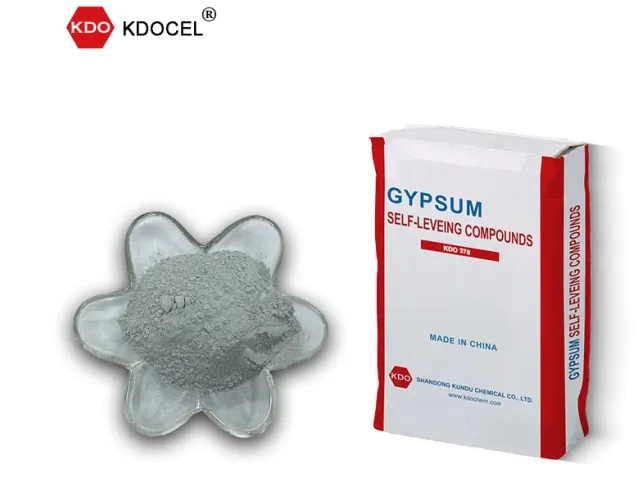- Time:2024/7/25Posted:SHANDONG KUNDU CHEMICAL CO.,LTD.
All well-known manufacturers of smoothing compounds and underlayments offer products based on both cement and calcium sulfate. What is the difference between gypsum-based and cement-based self-leveling compounds, and when should each be used?
Based on manufacturers' Product Data Sheets, these two product groups cover the entire spectrum of flooring. The relevant differences regarding substrate preparation are as follows:
- Cement-based leveling compounds shrink during setting and can develop relatively high stresses, with a pronounced tendency to crack. In contrast, gypsum-based compounds are practically stress-free.
- Cement-based leveling compounds bind the mixing water over a prolonged process, resulting in faster drying at greater thicknesses (> 3 mm). Gypsum-based compounds bind the mixing water very quickly, but at greater thicknesses, this leads to relatively long drying times. High-speed construction systems that dry ready for covering in only one hour are only possible with cement-based materials.
- Cement-based leveling compounds in standard formulations reach high strength. High-quality products achieve a compressive strength of 30 to 40 N/mm², whereas corresponding calcium sulfate-based products reach 25 to 35 N/mm².
- Cement-based leveling compounds are minimally affected by short-term moisture ingress, such as through joints in tiled flooring. However, gypsum-based compounds lose strength when they absorb water.
The choice between the two should be based on project requirements, considering the substrate and the proposed covering/intended use. From the differences described above, certain cases may favor the use of one material over the other, depending on the specific project requirements.

Substrates
Mastic Asphalt: Due to its high coefficient of thermal expansion and visco-elastic properties, mastic asphalt is very sensitive to temperature changes and external stresses, making it prone to damage. Old mastic asphalt should, therefore, be prepared with calcium sulfate-based compounds whenever possible. New, well-gritted mastic asphalt can also be prepared using "low stress" cement compounds, but only in limited thickness (max. 3 mm).
Mixed Substrates: These often occur due to planning changes during renovations. Mixed substrates, comprising different materials, are best handled with gypsum-based compounds.
Chipboard / Dry Screed Materials: Even when installed according to regulations, chipboard or prefabricated screed materials are more prone to deformation under load than cement- or calcium sulfate-based screeds. Using fiber-reinforced gypsum-based compounds can help avoid additional stress-related deformation.
Surface Coverings / Mechanical Loading
Resilient Materials: Rubber coverings place the highest demands on the surface strength of the leveling compound. Their high vapor diffusion resistance can prevent the evaporation of residual moisture from the leveling compounds and adhesives. Therefore, under these coverings, primarily high-strength cement-based compounds should be used.
Wood Flooring: Due to dimensional changes caused by moisture, wood flooring generates high shear forces between the flooring and the substrate. In these cases, higher strength cement-based products are preferable. However, the type and size of the wood also play a significant role, so manufacturer-specific recommendations may differ.
Wet Areas and Ceramic Tiles / Natural Stone: High exposure to moisture during both installation and use must be considered, practically excluding the use of gypsum-based compounds.
High Mechanical Loading: For areas exposed to high mechanical loading from heavy vehicle traffic (e.g., fork-lift trucks), high-strength cement-based leveling compounds should be used.
In summary, the preference for gypsum-based compounds is primarily influenced by the substrate, while the preference for cement-based compounds stems mainly from high-demand coverings and loadings. There are many crossover cases in which both types of leveling compounds can be suitable. Therefore, consulting further technical advice is recommended.





